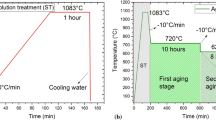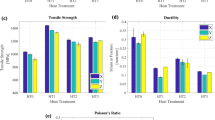Abstract
Optimization of metallic components fabricated from age hardenable alloys relies on the use of effective heat treatments. As additive manufacturing (AM) is taking its place as “another tool in the toolbox” for fabrication of metallic components, numerous processes are under development differing mainly by the starting feedstock and heat source. In parallel with these efforts is the optimization of the post-processing heat treatment to obtain the required properties. Due to differences in the various processes, it is expected that different microstructures will form in the AM specimens possibly affecting the mechanical behavior. To address optimization of heat treatments requires an understanding of how the starting microstructure responds to heat treatments. This study looks at inherent differences in the response of Inconel 718 to heat treatments developed for wrought 718. Three different AM processes were used to fabricate the samples in this study.




Similar content being viewed by others
References
SAE/AMS 5662, Nickel Alloy, Corrosion and Heat-Resistant, Bars, Forgings, and Rings 52.5Ni–19Cr–3.0Mo–5.1Cb (Nb)–0.90Ti–0.50Al–18Fe Consumable Electrode or Vacuum Induction Melted 1775°F (968°C) Solution and Precipitation Heat Treated (reaffirmed 2009–2006).
SAE/AMS 5663, Nickel Alloy, Corrosion and Heat-Resistant, Bars, Forgings, and Rings 52.5Ni–19Cr–3.0Mo–5.1Cb (Nb)–0.90Ti–0.50Al–18Fe Consumable Electrode or Vacuum Induction Melted 1775 °F (968 °C) Solution and Precipitation Heat Treated (reaffirmed 2009–2006).
SAE/AMS 5664, Nickel Alloy, Corrosion and Heat-Resistant, Bars, Forgings, and Rings 52.5Ni–19Cr–3.0Mo–5.1Cb (Nb)–0.90Ti–0.50AI–18Fe Consumable Electrode or Vacuum Induction Melted 1775 °F (968 °C) Solution Heat Treated, Precipitation-Hardenable (reaffirmed 2009–2006).
R.G. Carlson and J.F. Radavich, Superalloys, ed. E.A. Loria (Warrendale: TMS, 1989).
J.J. Schirra, Superalloys, ed. E.A. Loria (Warrendale: TMS, 1997), p. 439.
G.A. Rao, M. Kumar, M. Srinivas, and D.S. Sarma, MSEA 355, 114 (2003).
C.L. Qiu, M.M. Attallah, X.H. Wu, and P. Andrews, MSEA 564, 176 (2013).
C. Qiu, W. Xinhua, J. Mei, P. Andrews, and W. Voice, J. Alloys Compd. 578, 454 (2013).
L. Chang, W. Sun, Y. Cuyi, F. Zhang, and R. Yang, J. Alloys Compd. 590, 227 (2014).
M. Sundararaman, P. Mukhopadhyay, and S. Banerjee, MMTA 23A, 2016 (1992).
G.A. Knorovsky, M.J. Cieslak, T.J. Headley, A.D. Romig Jr, and W.F. Hammetter, MMTA 20A, 2149 (1989).
K. Chang, H. Lai, and J. Hwang, Superalloys, ed. E.A. Loria (Warrendale: TMS, 1994), p. 683.
T. Antonsson and H. Fredriksson, MMTB 36B, 85 (2005).
C. Radhakrishna and K.P. Rao, J. Mater. Sci. 32, 1977 (1997).
H. Qi, M. Azer, and A. Ritter, MMTA 40A, 2410 (2009).
A. Oradei-Basile and J.F. Radavich, Superalloys, ed. E.A. Loria (Warrendale: TMS, 1991), p. 325.
D. Cai, W. Zhang, P. Nie, W. Liu, and M. Yao, Mater. Charact. 58, 20 (2007).
A. Niang, B. Viguier, and J. Lacaze, Mater. Charact. 61, 525 (2010).
J.W. Brooks and P.J. Bridge, Superalloys, ed. S. Reicman, et al. (Warrendale: TMS, 1988), p. 33.
W.-D. Cao, Superalloys, ed. E.A. Loria (Warrendale: TMS, 2005), p. 165.
P.J. Paramo, L.A. Rezes Osorio, M.P. Guerrero Mata, M. De La Garya, and V. Paramo Lopez, Proc. Mater. Sci. 8, 1160 (2015).
S. Azadian, L.-Y. Wei, and R. Warren, Mater. Charact. 53, 7 (2014).
M. Anderson, A.-L. Thielin, F. Bridier, P. Bocher, and J. Savoie, MSEA 679, 48 (2018).
D.F. Paulonis, J.M. Oblak, and D.S. Duvall, Trans. ASM 62, 611 (1969).
J.F. Radavich, Superalloys, ed. E.A. Loria (Warrendale: TMS, 1989), p. 229.
R.G. Thompson, J. Dobbs, and D. Mayo, Weld J. 65, 299 (1986).
ASTM E1479, Standard Practice for Describing and Specifying Inductively Coupled Plasma Atomic Emission Spectrometers (ASTM International, West Conshohocken, 2016).
ASTM E1019, Standard Test Methods for Determination of Carbon, Sulfur, Nitrogen, and Oxygen in Steel, Iron, Nickel, and Cobalt Alloys by Various Combustion and Inert Gas Fusion Techniques (ASTM International, West Conshohocken, 2018).
ASTM E8/E8M-16a, Standard Test Methods for Tension Testing of Metallic Materials (ASTM International, West Conshohocken, 2016).
ASTM-International, Standard Specification for Additive Manufacturing Nickel Alloy (UNS No7718) with powder bed fusion. F3055-12 (ASTM International, West Conshohocken, 2014).
SAE/AMS 2774 Rev. E, Aerospace Material Specification for Wrought Nickel Alloy and Cobalt Alloy Parts, 2016.
G. Sjoberg, Superalloys, ed. E.A. Ott, et al. (Pittsburg: TMS, 2010), p. 117.
K.N. Amato, S.M. Gaytan, L.E. Murr, E. Martinez, P.W. Shindo, J. Hernandez, S. Collins, and F. Medina, Acta Mater. 60, 2229 (2012).
F. Liu, X. Lin, G. Yang, M. Song, J. Chen, and W. Huang, Opt. Laser Technol. 43, 208 (2011).
E. Chlebus, K. Gruber, B. Kuznikca, J. Kurzax, and T. Kurzynowski, MSEA 639, 647 (2015).
Acknowledgements
This manuscript in based in part on the Keynote talk given at the Second Asia-Pacific International Conference on AM (APICAM) held in Melbourne, Australia, in July 2019.
Funding
Funding was provided in part from the following NASA-Marshal Space Flight Grants: 80MSFC19M0017, PC 117217140, 80MSFC19M0015 and PC 11666785. Samples used in this study were obtained from the NASA-Marshall Space Flight Center, DM3D, DMG-Mori, Alabama Laser and Keystone Synergistic Enterprises. The data presented have been selected from on-going research within my group over the past several years with many student contributions.
Author information
Authors and Affiliations
Corresponding author
Ethics declarations
Conflict of interest
The author declares that she has no conflict of interest.
Additional information
Publisher's Note
Springer Nature remains neutral with regard to jurisdictional claims in published maps and institutional affiliations.
Electronic supplementary material
Below is the link to the electronic supplementary material.
Rights and permissions
About this article
Cite this article
Schneider, J. Comparison of Microstructural Response to Heat Treatment of Inconel 718 Prepared by Three Different Metal Additive Manufacturing Processes. JOM 72, 1085–1091 (2020). https://doi.org/10.1007/s11837-020-04021-x
Received:
Accepted:
Published:
Issue Date:
DOI: https://doi.org/10.1007/s11837-020-04021-x




